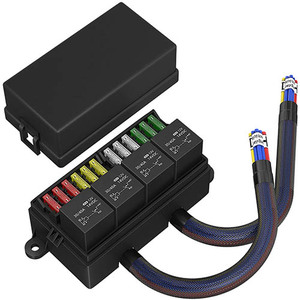Streamlining Electrical Systems: The Significance of Automotive Fuse and Relay Boxes
Body
Central to the effective and safe operation of these systems is the automotive fuse and relay box. This unassuming yet crucial component plays a vital role in safeguarding the vehicle's electrical infrastructure while ensuring optimal functionality.
The Anatomy of an Automotive Fuse And Relay Box
Fuses
Fuses are the unsung heroes of automotive electrical systems. They act as protective devices that interrupt the flow of electric current when a circuit is overloaded or experiences a short circuit. This prevents damage to components and, more importantly, reduces the risk of electrical fires.
Relays
Relays are electrical switches that enable the control of high-current circuits with low-current signals. In an automotive context, relays are essential for managing power-hungry components like headlights, air conditioning systems, and fuel pumps. They act as intermediaries, ensuring that the high-current flow required by these components does not pass directly through the vehicle's control switches.
Fuse and Relay Box
The fuse and relay box serve as the nerve centre of a vehicle's electrical system. It is a centralized unit that houses various fuses and relays, each dedicated to specific circuits and components. This organization makes it easier for technicians to troubleshoot and replace individual fuses or relays when needed.
The Role of Automotive Fuse and Relay Boxes

Overcurrent Protection
The primary function of automotive fuses is to protect electrical circuits from overcurrent situations. When a circuit draws more current than it can safely handle, the fuse "blows," breaking the circuit and preventing damage to the components.
Circuit Management
Relays play a pivotal role in managing high-current circuits efficiently. By acting as electrical switches, relays enable the control of power-hungry devices without overloading the vehicle's control switches, ensuring smooth operation and longevity of these components.
Enhanced Safety
Automotive fuse and relay boxes significantly contribute to vehicle safety. In the event of a short circuit or electrical malfunction, the fuses prevent electrical fires and damage, thereby safeguarding both the vehicle and its occupants.
Simplified Maintenance
The centralized design of fuse and relay boxes simplifies maintenance and troubleshooting. Technicians can quickly identify and replace faulty fuses or relays, reducing diagnostic time and overall repair costs.
Evolution in Automotive Electronics
The automotive industry is witnessing a rapid evolution in electronic systems, with vehicles incorporating advanced features such as autonomous driving, electrification, and connectivity.
This progression places even greater importance on the reliability and efficiency of automotive fuse and relay boxes. Manufacturers are continually innovating to develop more compact, intelligent, and robust designs that can accommodate the increasing complexity of modern vehicles.
Conclusion
In the ever-evolving landscape of automotive technology, the automotive fuse and relay box stands as a critical component that ensures the reliable and safe operation of a vehicle's electrical systems.
As vehicles become more sophisticated, the role of these unassuming boxes becomes increasingly vital. Providing a centralized and efficient means of managing electrical circuits, fuse and relay boxes contributes to both the performance and safety of modern automobiles, ultimately enhancing the driving experience and meeting the demands of an electrified future.










Comments